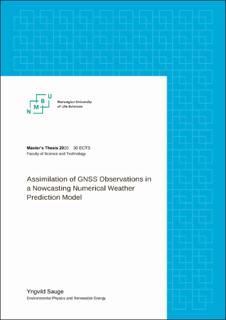| dc.description.abstract | Nowcasting, a very short-term weather forecasting, has been more and more used in the later years, due to improved forecast models and more computing power. More frequent weather forecast updates depend on observations that can be collected frequently. An observation that can be collected every hour is the GNSS Zenith Total Delay (ZTD), which is the delay in a satellite signals ray to a receiver due to the composition of the atmosphere, converted to a humidity measurement. This dissertation studies the impact GNSS ZTD observations on a rapid refresh nowcasting system. Two experiments, with, and without GNSS ZTD observations, have been performed. The bias of the GNSS ZTD observations was corrected using a variational approach.
Nowasting with seven hour forecasts was updated every third hour. A Rapid Refresh (RR) scheme – a non cycled data assimilation and forecast system – was used as nowcasting approach, using short-range forecasts from a three hour cycling system as initial state. The impact of the GNSS ZTD observations was evaluated by comparing the analyses and forecasts of the two above mentioned experiments against observations.
Results from the two experiments showed that there is a difference between the two model runs. The most remarkable differences could be seen in relative and specific humidity, wind speed, wind direction, and one and six hour accumulated precipitation forecasts. Significant difference in root-mean-square error (RMSE) was observed between the two experiments, especially during the first two hours of the forecast at some of the nowcasting times. The bias correction of the observations was successful for some of the stations used to collect GNSS ZTD observations. But, some of the stations showed a clear spin-up observed during the first ten days. All the stations used to collect the GNSS ZTD observations was located in Sweden.
A promising positive impact of GNSS ZTD was found, but further development is needed to get a stable improvement from this observation in a RR system. Furthermore, use of more observations from other countries inside the domain and more careful bias correction would be advantageous. | en_US |

